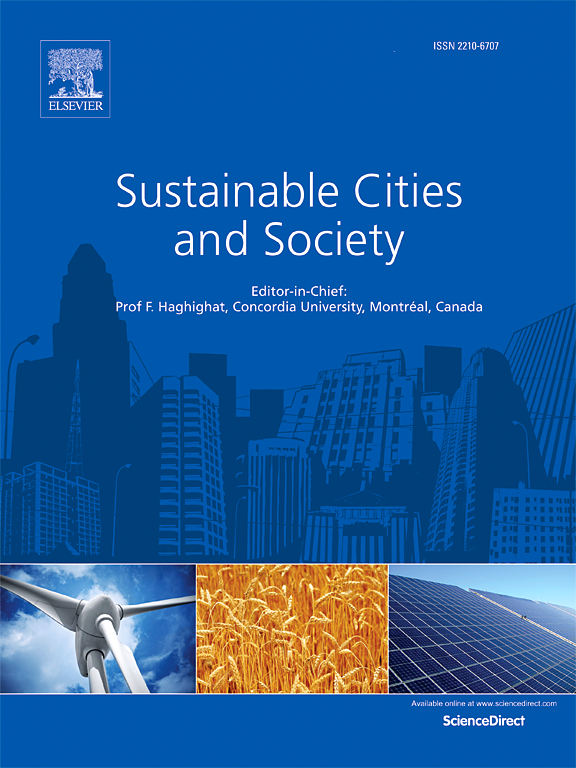植被生长和城市发展对小气候和建筑能耗的动态影响
IF 10.5
1区 工程技术
Q1 CONSTRUCTION & BUILDING TECHNOLOGY
引用次数: 0
摘要
城市热浪已成为一项重大的全球挑战,它加剧了极端天气状况,并导致建筑能耗增加。这些挑战在城市扩张的初始阶段变得尤为尖锐。虽然许多研究已经独立调查了植被对室外小气候和建筑能效的影响,但植被生长、城市发展和热浪缓解之间的动态相互作用仍未得到充分探索。本研究以中国东南大学新校区为例,通过对气候变化背景下室外小气候参数和室内能源性能的综合分析,探讨了这些不断演变的相互关系。根据树木生长和城市建设的不同阶段,开发了四种情景:气候变化,计划,停止建设,计划中增加树木。通过模拟和实验来评估这些情景中动态变化的影响。通过ENVI-met和EnergyPlus工具评估了这些因素对小气候和建筑能耗的长期影响。结果表明:60年后,植被生长可使场地平均温度降低约3°C,扩大热舒适增强面积,使建筑总制冷能耗降低15.5%。对比分析表明,保留现有树木或实施早期造林可以显著缓解热浪,减少制冷能源需求。本研究为未来城市更新和城市可持续发展提供了有价值的见解,为城市规划者优化城市环境和提高能源效率提供了实践指导。本文章由计算机程序翻译,如有差异,请以英文原文为准。
Dynamic impacts of vegetation growth and urban development on microclimate and building energy consumption
Urban heatwaves have emerged as a critical global challenge, exacerbating extreme weather conditions and contributing to higher building energy consumption. These challenges become particularly acute during the initial phases of urban expansion. While numerous studies have independently investigated vegetation's effects on outdoor microclimates and building energy efficiency, the dynamic interactions between vegetation growth, urban development, and heatwave mitigation remain underexplored. This research examines these evolving interrelationships through integrated analysis of outdoor microclimate parameters and indoor energy performance in the context of climate change, using the new campus of Southeast University in China as a case study. Four scenarios are developed based on different stages of tree growth and urban construction: climate change only, as plan, stop construction, add trees in plan. Both simulations and experiments are conducted to assess the impact of the dynamic changes in these scenarios. The long-term impacts of these factors on microclimate and building energy consumption are assessed by ENVI-met and EnergyPlus tools. The results indicate that after 60 years, vegetation growth can reduce the average site temperature by approximately 3 °C, expand areas of enhanced thermal comfort, and reduce total building cooling energy consumption by 15.5 %. Comparative analysis of the scenarios reveals that preserving existing trees or implementing early-stage plantation can significantly mitigate heatwave and reduce cooling energy demand. This research provides valuable insights for future urban renewal and sustainable city development, offering practical guidance for urban planners to optimize urban environments and improve energy efficiency.
求助全文
通过发布文献求助,成功后即可免费获取论文全文。
去求助
来源期刊

Sustainable Cities and Society
Social Sciences-Geography, Planning and Development
CiteScore
22.00
自引率
13.70%
发文量
810
审稿时长
27 days
期刊介绍:
Sustainable Cities and Society (SCS) is an international journal that focuses on fundamental and applied research to promote environmentally sustainable and socially resilient cities. The journal welcomes cross-cutting, multi-disciplinary research in various areas, including:
1. Smart cities and resilient environments;
2. Alternative/clean energy sources, energy distribution, distributed energy generation, and energy demand reduction/management;
3. Monitoring and improving air quality in built environment and cities (e.g., healthy built environment and air quality management);
4. Energy efficient, low/zero carbon, and green buildings/communities;
5. Climate change mitigation and adaptation in urban environments;
6. Green infrastructure and BMPs;
7. Environmental Footprint accounting and management;
8. Urban agriculture and forestry;
9. ICT, smart grid and intelligent infrastructure;
10. Urban design/planning, regulations, legislation, certification, economics, and policy;
11. Social aspects, impacts and resiliency of cities;
12. Behavior monitoring, analysis and change within urban communities;
13. Health monitoring and improvement;
14. Nexus issues related to sustainable cities and societies;
15. Smart city governance;
16. Decision Support Systems for trade-off and uncertainty analysis for improved management of cities and society;
17. Big data, machine learning, and artificial intelligence applications and case studies;
18. Critical infrastructure protection, including security, privacy, forensics, and reliability issues of cyber-physical systems.
19. Water footprint reduction and urban water distribution, harvesting, treatment, reuse and management;
20. Waste reduction and recycling;
21. Wastewater collection, treatment and recycling;
22. Smart, clean and healthy transportation systems and infrastructure;
 求助内容:
求助内容: 应助结果提醒方式:
应助结果提醒方式:


